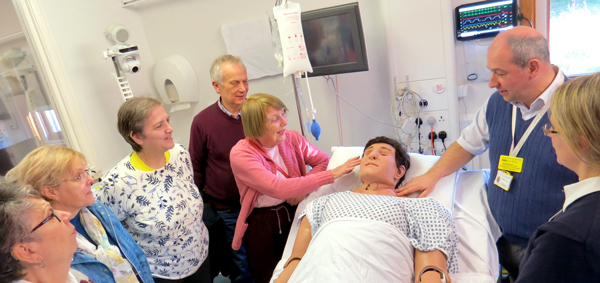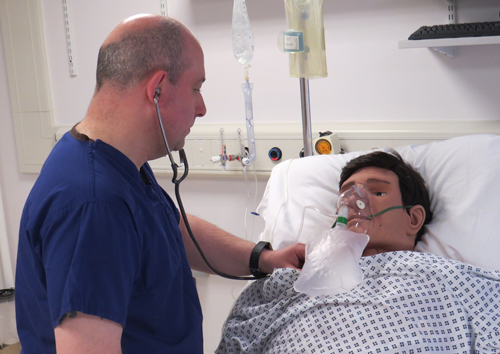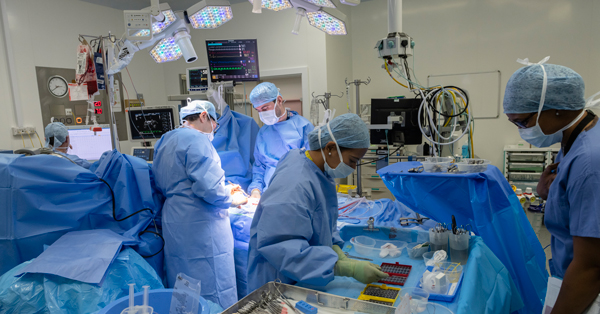We believe in sharing our knowledge through teaching, so that what we learn can help patients everywhere.
Training is a crucial part of our work and we have training facilities at both Royal Brompton and Harefield to give clinical staff access to the most up-to-date training and teaching.
We train our team in various complex procedures, crisis management and better team working, to better equip them in their roles. Our training is internationally renowned, with teaching provided by experts in their fields, and it attracts attendees from around the world.
The power of simulation
 State-of-the-art simulation mannequins and highly immersive situations are used to prepare our teams for a range of different scenarios, ranging from a deteriorating patient in paediatric intensive care, to a patient being flown to Harefield's heart attack centre. This year, the education team acquired two new state-of-the-art mannequins - one for each hospital site - to add an extra layer of realism to the simulation experience.
State-of-the-art simulation mannequins and highly immersive situations are used to prepare our teams for a range of different scenarios, ranging from a deteriorating patient in paediatric intensive care, to a patient being flown to Harefield's heart attack centre. This year, the education team acquired two new state-of-the-art mannequins - one for each hospital site - to add an extra layer of realism to the simulation experience.
The mannequins cost £45,000 each and feature highly realistic anatomy and skin texture, articulated limbs and joints. They can make sounds, blink and breathe.
The new mannequins are a far cry from the origins of simulation, which began with 'part task' training tools such as a model arm to practise inserting cannulas or a torso for birthing.
 Andrew Sykes, clinical skills and simulation centre manager, said: "With part-task training, you are teaching a task. Modern simulation is an experience and enables us to practise for clinical events that most staff are unlikely to see particularly regularly.
Andrew Sykes, clinical skills and simulation centre manager, said: "With part-task training, you are teaching a task. Modern simulation is an experience and enables us to practise for clinical events that most staff are unlikely to see particularly regularly.
"We have a particular focus on team training and encouraging multidisciplinary working. Historically, training has often been divided between doctors, nurses and allied health professionals, but in our Trust, we recognise that when there is an incident, all these professions need to work together and human factors come into play, so that is what we are practising for when we run simulations.
"In the 13 years I've been working medical education, the advances in technology have been minor compared with other areas of medicine, but what really has evolved is our understanding of how we use simulation as a teaching tool and how to get the maximum value out of it."
The value of hands-on experience
 A new training programme launched this year gives junior doctors the opportunity to learn how to carry out an advanced procedure on patients.
A new training programme launched this year gives junior doctors the opportunity to learn how to carry out an advanced procedure on patients.
Our highly trained consultant cardiothoracic anaesthetists at Harefield Hospital routinely insert 'central lines' into the larger veins of patients about to go into surgery. Once in surgery, the lines are used to supply the patients with medication.
Now members of the team are teaching junior doctors to carry out this advanced procedure in the same live environment.
Francesca Caliandro, consultant cardiothoracic anaesthetist, who led the initiative, explained: "Until last year, junior doctors could only practise inserting central lines into a mannequin in one of our laboratories. They acquired the skills involved, but there's no substitute for doing the real thing.
"Now they each receive a day's one-to-one training with a consultant, during which they learn to insert central lines in patients."
Dr Mohamed Zuhair, one of the junior doctors who has taken part in the programme, said: "It's really valuable because it equips you with advanced skills to carry out the procedure on patients who may urgently need to be treated in other medical situations in future - without having to wait for an anaesthetist to arrive."
